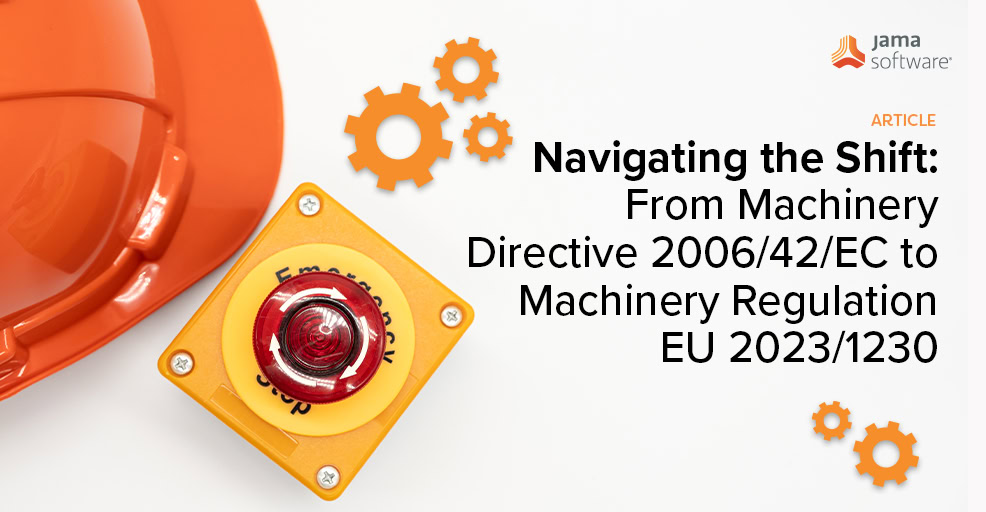 .
.
Navigating the Shift: From Machinery Directive 2006/42/EC to Machinery Regulation EU 2023/1230
Change is inevitable, especially in regulatory frameworks governing industries. In Europe, the transition from the Machinery Directive 2006/42/EC to the new Machinery Regulation EU 2023/1230 marks a significant step forward in ensuring safety, innovation, and harmonization in the machinery sector. This transition brings both challenges and opportunities for manufacturers, regulators, and stakeholders alike. The new regulation will go into effect in January of 2027. In this blog post, we’ll delve into the key aspects of this transition and explore its implications.
RELATED: Jama Connect® for Automotive
Understanding the Machinery Directive 2006/42/EC
Enacted in 2006, the Machinery Directive 2006/42/EC aimed to harmonize safety standards for machinery across the European Union (EU). It established essential health and safety requirements (EHSRs) that machinery must meet before being placed on the EU market or put into service. The directive provided guidelines for manufacturers to ensure that their machinery was designed and constructed to be safe for use.
Challenges and Limitations
While the Machinery Directive 2006/42/EC was a milestone in ensuring safety standards, over time, certain challenges and limitations became apparent. Rapid technological advancements, emerging risks, and inconsistencies in interpretation and application highlighted the need for a more robust regulatory framework.
The Machinery Regulation EU 2023/1230
A Step Forward: Recognizing the need for an updated and enhanced regulatory framework, the EU introduced the Machinery Regulation EU 2023/1230. This new regulation builds upon the foundation laid by its predecessor while addressing the shortcomings identified over the years.
Key Changes and Enhancements:
- Scope Expansion: The Machinery Regulation EU 2023/1230 expands the scope to cover a wider range of products, including certain partially completed machinery and safety components. This broader scope ensures that all relevant products are subject to uniform safety standards.
- Risk Assessment and Mitigation: The new regulation emphasizes a risk-based approach to safety, requiring manufacturers to conduct comprehensive risk assessments throughout the machinery’s lifecycle. This proactive approach aims to identify and mitigate potential hazards more effectively.
- Digitalization and Connectivity: With the rise of Industry 4.0, the Machinery Regulation EU 2023/1230 addresses the integration of digital technologies and connectivity in machinery. It sets out requirements for cybersecurity, data protection, and interoperability to ensure the safe and secure operation of digitally enabled machinery.
- Market Surveillance and Enforcement: Enhanced market surveillance measures and stricter enforcement mechanisms are integral parts of the new regulation. Authorities are empowered to monitor compliance more closely and take swift action against non-compliant products, safeguarding the safety of end-users.
- Implications and Considerations: The transition from the Machinery Directive 2006/42/EC to the Machinery Regulation EU 2023/1230 presents both challenges and opportunities for stakeholders. Manufacturers need to adapt their processes and products to meet the updated requirements, investing in research, development, and compliance measures. Regulatory bodies must ensure smooth implementation and provide guidance to facilitate the transition for businesses.
RELATED: Traceable Agile™ – Speed AND Quality Are Possible for Software Factories in Safety-critical Industries
The transition from the Machinery Directive 2006/42/EC to the Machinery Regulation EU 2023/1230 signifies a proactive response to evolving challenges and opportunities in the machinery sector. By embracing enhanced safety standards, risk-based approaches, and digitalization, the EU aims to foster innovation while prioritizing the safety and well-being of users. As stakeholders navigate this transition, collaboration, adaptability, and adherence to best practices will be essential for ensuring a smooth and successful implementation of the new regulatory framework.
Note: This article was drafted with the aid of AI. Additional content, edits for accuracy, and industry expertise by McKenzie Jonsson and Matt Mickle.
- Navigating AI Safety with ISO 8800 in Road Vehicles - August 7, 2025
- Automotive Industry Signs Memorandum of Understanding - July 15, 2025
- Construction’s Next Leap: AI as a Strategic Partner - June 26, 2025